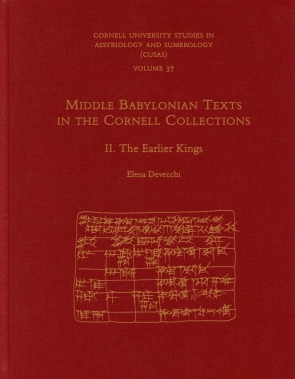Middle Babylonian Texts in the Cornell Collections, Part II
The Earlier Kings
Elena Devecchi
This volume completes the publication of Middle Babylonian texts from the Rosen Collection that date to the Kassite period, a project that was initiated by Wilfred H. van Soldt with CUSAS 30 in 2015. In this book, Elena Devecchi provides full transliterations, translations, and extended commentaries of 338 previously unpublished cuneiform tablets from Kassite Babylonia (ca. 1475–1155 BCE). Most of the texts are dated to the reigns of Nazi-Maruttaš and Kadašman-Turgu, but the collection also includes one tablet dating to the reign of Burna-Buriaš II and a few documents from the reigns of Kadašman-Enlil II, Kudur-Enlil, and Šagarakti-Šuriaš, as well as some that are not dated.
- Description
- Bio
- Table of Contents
- Sample Chapters
The tablets published here are largely administrative records dealing with the income, storage, and redistribution of agricultural products and byproducts, animal husbandry, and textile production, while legal documents and letters comprise a smaller portion of the collection. Evidence suggests that these documents originated from an administrative center that interacted closely with the provincial capital Nippur and must have been located in its vicinity. They thus expand significantly our previous knowledge of the Nippur region under Kassite rule, hitherto almost exclusively based on sources that came from Nippur itself, and provide substantial new data for the study of central aspects of society, economy, and administration that traditionally lie at the core of research about Kassite Babylonia.
Elena Devecchi is Professor of History of the Ancient Near East at the University of Turin.
Series Editor’s Preface
Acknowledgments
Abbreviations and conventions
Catalogue
Concordances
Introduction
1. Origin of the tablets
1.1. The Nippur area
1.2 Dûr-Enlilç
1.3 House of Enlil-kidinnî, or Bît-Enlil-kidinnî?
2. Remarks on individual text groups
2.1 Accounts of agricultural revenues
2.2 Expenditures
2.3 Flock records
3. Economic activities
3.1 Primary production
3.1.1 Agriculture
3.1.2 Animal husbandry
3.2 Secondary production
3.2.1 Milling
3.2.2 Brewing
3.2.3 Textile industry
4. Administrative structure
4.1. The main actors
4.2. Further officials
4.3 Administrative units
4.4. Storage facilities
4.5 Temples
4.6 Interactions with the royal and provincial government
Texts
1. ADMINISTRATION OF AGRICULTURAL PRODUCTS
1.1 ACCOUNTS OF AGRICULTURAL REVENUES
1.1.1 Annual tçlîtu-accounts of a single town
i. Barley together with other cereals, pulses and cress (1–16)
ii. Sesame (17–21)
1.1.2 Annual tçlîtu-accounts of several towns
i. Barley together with other cereals, pulses and cress (22–23)
ii. Sesame (24)
iii. Wheat (25)
1.1.3 Annual EDIN-accounts for one town (26–36)
1.1.4 Accounts of shares (37–39)
1.1.5 Other accounts of revenues (40–46)
1.2 STORED GOODS
1.2.1 “Stored barley/grain” (47–57)
1.2.2 “Rest of the stores” (58–60)
1.2.3 Stored flour (61)
1.3EXPENDITURES
1.3.1Single expenditures (62–91)
1.3.2Multiple expenditures for one purpose
i. Rations (92–104)
ii. Fodder (105–107)
iii. Seed (108–109)
iv. Production supplies (110–117)
v. Food allocations for temples (118–119)
vi. Loan with interest (120–122)
vii. “Delivery” (123)
viii. Gifts (124–125)
ix. “Exchange” (126)
1.3.3Multiple expenditures for various purposes (127–190)
1.3.4Aklu-expenditures of foodstuffs
i. Single aklu-expenditures (191–235)
ii. Summaries of aklu-expenditures (236–245)
2. ADMINISTRATION OF ANIMAL HUSBANDRY
2.1 Sheep (246–253)
2.2 Goats (254)
2.3 Sheep and Goats (255–262)
2.4 Cattle (263–266)
3. TEXTILE PRODUCTION
3.1 Allocation of wool as work material (267–272)
3.2 Production of garments and textiles (273–290)
4. MISCELLANEOUS ADMINISTRATIVE TEXTS
4.1 Personnel lists (291–292)
4.2 Beer (293)
4.3 Beer and bread (294)
4.4 Beer and draff (295)
4.5 Pig’s fat (296)
4.6 Receipt of aromatics and disbursement of cereals (297)
4.7 Hides (298–299)
4.8 Bricks (300)
4.9 Paint (301)
4.10 Wood (302)
4.11 Sickles (303)
4.12 Sacks (304)
4.13 Metal (305)
4.14 Inventory of precious goods (306)
4.15 Uncertain (307–323)
5. LEGAL TEXTS
5.1 tuppi aḫûzati (324)
5.2 Contract of exchange (325)
5.3 Purchase of an ox (326)
5.4 Settlements of disputes (327–328)
5.5 Loans (329–331)
5.6 Uncertain (332–334)
6. LETTERS (335–338)
7. REFERENCES
8. INDEXES
7.1 Personal Names
7.2 Professions
7.3 Geographic Names
7.4 Temples
7.5 Cuneiform sources
9. PLATES
Download a PDF sample chapter here: Introduction
Also of Interest
Mailing List
Subscribe to our mailing list and be notified about new titles, journals and catalogs.






